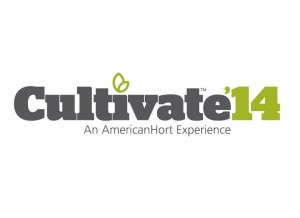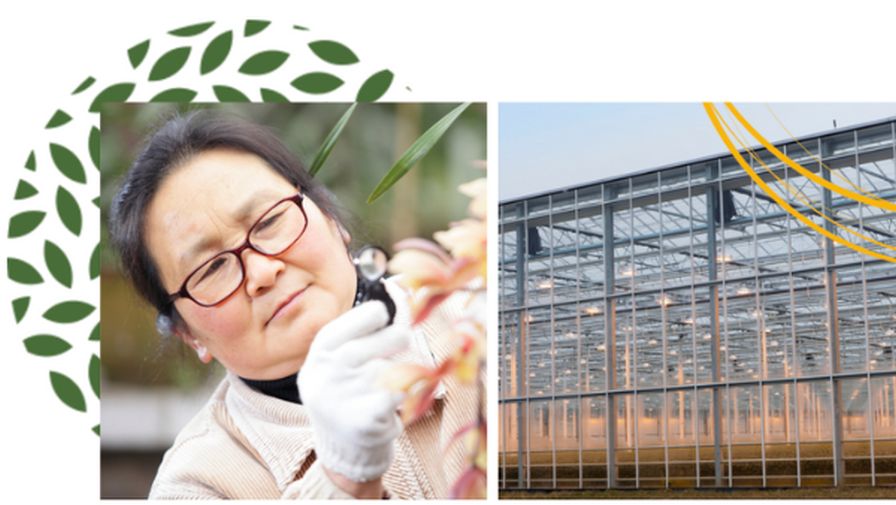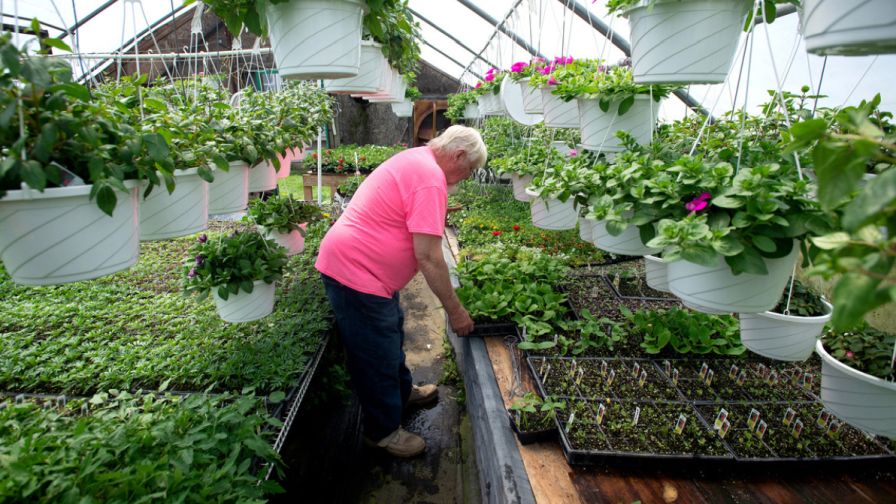Cultivate’14 Town Hall Smackdown: Breaking The Frenemy Impasse
 One of the highlights of Cultivate’14 was the Town Hall Meeting, a tradition held over from OFA Short Course, in which a controversial subject is broached and industry panel members and audience members go head-to-head in a virtual smackdown type of debate. This year’s Town Hall Meeting theme, held Sunday, July 13, was “Breaking the Frenemy Impasse.”
One of the highlights of Cultivate’14 was the Town Hall Meeting, a tradition held over from OFA Short Course, in which a controversial subject is broached and industry panel members and audience members go head-to-head in a virtual smackdown type of debate. This year’s Town Hall Meeting theme, held Sunday, July 13, was “Breaking the Frenemy Impasse.”
A panel of young professionals representing all levels of the floriculture industry supply chain discussed the disconnects in communication from the breeder level all the way down to the retailer, and how to overcome the malaise that exists between the involved parties.
The panel included: Lisa Higby Lefevre, Distinctive Gardens, Inc.; Jonathan Cude, Sedan Floral Inc.; Stephanie Whitehouse-Barlow, Peace Tree Farm; Bill Calkins, Ball Horticultural Co.; Kelly Norris, Greater Des Moines Botanical Garden; and Jonathan Pederson, Monrovia Nursery.
Panelists decided that all levels of the supply chain must concentrate on creating a better, more informed consumer. It’s something that will take teamwork from all sides. It’s the retailers’ responsibility to know their own region and the finer points of their communities. Growers are responsible for knowing about the plants they grow. Breeders market to the grower, who markets to the retailer, but the challenge is ultimately in getting that information to the consumer.
“Those Damned Tags”
A large point of discussion was dedicated to tags — specifically, who is responsible for them and what information they should include. Panelists discussed the need for tags to be easier for consumers to understand and interpret, and also the need for more specific, regional information to be disseminated at the retail level.
There are many frustrations related to the topic of tags, said one panelist. While they often provide knowledge to growers, they also need to include layman’s terms for the consumer.
But from a retail standpoint, there is a need to get rid of generic, “no-brainer” tags, especially ones like Perennial Purple Fountain Grass, which promotes inaccurate information to consumers. We need to offer consumers as much information as possible.
A panelist suggested that something as simple as signage could help fill in the blanks for customers who aren’t finding the information they need on a tag. At retail, organizing plants in sections by sun, shade, etc. using signage, helps communicate plant needs with consumers and helps them sell plants.
Consumers also often seek out people for knowledge at retail, especially if they are not reading tags or are confused by tags.
An audience member asked if tags have outlasted their usefulness – perhaps a technology like Aurasma could help consumers, with built-in, scannable videos. But a panelist said while technology is a great thing, breeders, growers and retailers couldn’t get people to use QR codes, so it would likely be as challenging or more to get them to use Aurasma.
Another panelist said though it seems tags are a necessary evil, they may contribute to the segmentation of our industry, and we need to figure out a way to decide who will disseminate information. All levels of the supply chain need to be ambassadors to help with information sharing.
An audience member said NFC, or smart tags, are the future, though the process seems too complicated.
Improving Communication From Breeder To Consumer
The real issue, panelists decided, is not tags but rather communication of information up and down the chain, from breeder to consumer. There seems to be a break in the chain.
McDonald’s was used as an example. It has one corporate identity, but it doesn’t advertise to the franchise and expect the franchise to communicate with the consumer. The corporation instead advertises directly to the consumer, who in turn comes to his or her local franchise to demand burgers.
One panelist said that would work if there was only one supplier and a limited number of products, but in floriculture, we have an abundance of both.
Amazon changed the rules of the book publishing game, said another panelist. Our industry, likewise, is waiting on a disruptive force like Amazon, to change the model of the way we do business. When consumers have more power, the result is great products. But the current model dilutes their experience. When we change the rules of the game, then we’ll change the conversation and attitude about plants with consumers.
We would be moving in the same direction if all of us were talking to the consumer, and not relying on the retailer to do it, one panelist said. In many ways, another panelist said, that’s already happening, with breeders and growers bypassing retail to speak directly to the consumer through social media, which drives consumers to the store.
A grower panelist said he offers garden club tours where they can see the plants, then tell them where to go to buy them. Host a consumer day at the grower operation, where they can meet the owner and learn where their plants are coming from – it helps put a person’s face to the plants.
Selling plants used to be easy but it’s not easy anymore. It’s harder and more complicated and the industry is mature, so we don’t have the growth that we used to have, said one panelist. To drive growth and opportunity in a mature market, we need to look at what need to do to disrupt it. If we keep doing things the same way, we’re not going to change a mature market.
To that point, another panelist asked where there is information about floriculture being a mature market, and if it’s really that the market is maturing, or that old attitudes about our business is causing it to stagnate.
The next generation is larger but buying power will be stretched over many years. Right now, they’re at the bottom of that. They’re buying homes later, getting into plant purchases later. For the next 10 years, the industry will be in a lull, one panelist predicted. Meanwhile, our demographics and target markets are changing, causing need for bilingual tags and more attention to the diversifying face of the consumer.
Switching Gears To More Immediate Needs
One retailer expressed frustration with growers who contact her days before she is supposed to receive a certain product, saying that they will not be able to deliver it. At that point in the process, the retailer has already put a lot of effort into marketing the plant, only to find out on short notice that she will not have it for her customers. There needs to be more communication, she said.
A grower on the panel said for a number of years, retailers would come in to his operation with the same complaint. He said he left the door wide open, with plenty of communication. Only after five or six years could he break that impasse, for retailers to believe him that he would deliver what he promised.
From a grower standpoint, the fear is the same, he said. “I’ll grow it for you, but then I’m afraid you’ll cancel the order. So let’s commit to sharing the risk.”
Another grower on the panel said annuals is easy – try growing trees or shrubs, where you’re talking about a five-year process. He said he’s making decisions today for what will be sold in 2017, and has to know what consumers will be looking for. But that doesn’t account for the weather challenges that no one expected and for which we have no time to react.
Meanwhile, growers and retailers alike are frustrated when breeders promote a hot crop, and book a ton of sales against it, but then go back to the cutting farm or the tissue lab and the supply isn’t there.
An audience member said perhaps pay-by-scan is the answer. But that requires the grower to merchandise. The grower panel member said he is fully willing to custom-grow plants, but that he needs retailers to share the risk, and pay-by-scan is not a model of shared risk. All the risk is on the grower.There are other ways to share risk beyond pay-by-scan.
Next Generation Of Consumers
Millennials are not afraid of hard work. They want cool stuff and they want to create cool stuff that their friends don’t have. We need to stop trying to cram me-too varieties down their throats and focus on unique products, one audience member said.
At special events like public pop-up gardens, the attending demographic was more interested in the unique pieces and parts there, a panelist said. Millennials are project-oriented. They like tangible projects with a cool outcome. Spinning the use of plants as do-it-yourself projects illustrates the idea that “project-based” is better than “work,” which is how consumers currently see gardening.
Consumers are looking for inspiration and information. We’re missing that now. So we need to ask how can breeders, growers and retailers can work together to provide it?
Should We Slow Down Breeding?
A breeder representative said we could slow down breeding to cut down the number of me-toos, but breeders need those varieties to maintain their relevance. They also need to continue to improve genetics to solve grower problems and improve plant quality for end consumers, so they can be more successful.
But at the same time, another panelist chimed in, consumers have a harder time making a decision when there are too many choice. It breaks down their confidence.
In the grower and retailer segments, 80 percent of the conversation is what is the new item, one panelist said. Sales derived from new plants sometimes works remarkably well, but often the lifespan of a new bedding plant variety is short. Most are one- or two-year plants. But if it’s a good variety, it turns into a bread and butter plant. Whereas a few years ago, it was under-supplied and overly coveted, today it’s bread and butter.
We Need To Drive And Play Into Consumer Interest
Can we influence a generation of buyers that is more informed, asked one panelist. Look at food culture – it has changed so much that there is a company like Williams Sonoma. So you can go to a restaurant where you have sweet corn gelato and if you love it, Williams Sonoma is the place you can go to buy the stuff you need to make it. That’s the attitude our industry needs. We need to provide that opportunity to show consumers how to use our plants but instead, we’re still chasing after the begonia and marigold dollars. Meanwhile, the consumer is confused from trying to choose between hundreds of varieties of each.
Enough is enough, he said – we need to get rid of some. Consumers don’t know the new stuff from the old stuff unless you tell them.
But we’re telling them new is better, and building that conception, said another panelist. The consumer continues to buy new but they’re not always the best.
When you find plants that solve grower problems and consumer problems, those are the ones that get adopted, a breeder panelist said. There were around 3,000 new varieties introduced this year. Most were bred to solve a pain – usually the grower pain. It’s a minor upgrade that results in a better plant.
The number one Googled genus is hydrangea. Consumers are asking for hydrangeas because that’s what they know and see. That’s what they like and want to use, and want information about, said a grower.
Maybe it’s not even so much about how many varieties are on the market, but rather just about supplying information on how to use those plants in a way that will provide satisfaction to the consumer, one audience member suggested.
Breeding companies provide samples of new plants to garden writers, said a breeder. Growers and retailers can do the same, promoting plants to writers and bloggers in their communities. The breeder challenged retailers – why not send samples to key customers and ask them to write about them? That’s a great way to use social media to gain interest in plants and your store.










